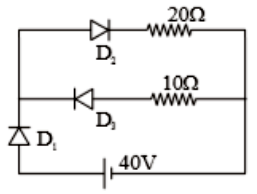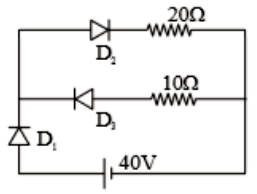The temperature (T) dependence of resistivity () of a semiconductor is represented by
1. 
2. 
3. 
4. 
एक अर्धचालक की प्रतिरोधकता () की तापमान (T) निर्भरता का निरूपण किसके द्वारा किया जाता है?






Which of the following is correct for n-type semiconductor?
1. Electron is majority carriers and trivalent atoms are dopants.
2. Electrons are majority carriers and pentavalent atoms are dopants.
3. Holes are majority carriers and pentavalent atoms are dopants.
4. Holes are majority carriers and trivalent atoms are dopants.
निम्नलिखित में से कौन-सा n-प्रकार अर्धचालक के लिए सही है?
1. इलेक्ट्रॉन बहुसंख्य वाहक होते हैं और त्रिसंयोजक परमाणु अपमिश्रक होते हैं।
2. इलेक्ट्रॉन बहुसंख्य वाहक होते हैं और पंचसंयोजक परमाणु अपमिश्रक होते हैं।
3. कोटर बहुसंख्य वाहक होते हैं और पंचसंयोजक परमाणु अपमिश्रक होते हैं।
4. कोटर बहुसंख्य वाहक होते हैं और त्रिसंयोजक परमाणु अपमिश्रक होते हैं।
The conductivity of an n-type semiconductor whose density of conduction electrons is , Density of holes is , Mobility of conduction electrons is and Mobility of holes is will be
1.
2.
3.
4.
ऐसे n-प्रकार के अर्धचालक की चालकता क्या होगी, जिसका चालन इलेक्ट्रॉनों का घनत्व है, कोटरों का घनत्व है, चालन इलेक्ट्रॉनों की गतिशीलता है और कोटरों की गतिशीलता है?
1.
2.
3.
4.
The input resistance of a silicon transistor is
100 . Base current is changed by 40
which results in a change in collector current
by 2 mA. This transistor is used as a common-
emitter amplifier with a load resistance of 4 k.
The voltage gain of the amplifier is
1. 2000
2. 3000
3. 4000
4. 1000
एक सिलिकॉन ट्रांजिस्टर का निवेशी प्रतिरोध 100 है। आधार धारा 40 से परिवर्तित होती है, जिसके परिणामस्वरूप संग्राहक धारा 2mA से परिवर्तित होती है। इस ट्रांजिस्टर का उपयोग 4k के लोड प्रतिरोध के साथ उभयनिष्ठ उत्सर्जक प्रवर्धक के रूप में किया जाता है। प्रवर्धक के वोल्टेज लाभ की गणना कीजिए:
1. 2000
2. 3000
3. 4000
4. 1000
Consider an NPN transistor amplifier in the common-emitter configuration. The current gain of the transistor is 100. If the collector current changes by 1 mA, what will be the change in emitter current?
(a) 1.1 mA (b) 1.01 mA
(c) 0.01 mA (d) 10 mA
उभयनिष्ठ-उत्सर्जक विन्यास में NPN ट्रांजिस्टर प्रवर्धक पर विचार कीजिए। ट्रांजिस्टर का धारा लाभ 100 है। यदि संग्राहक धारा 1 ma से परिवर्तित होती है, तब उत्सर्जक धारा में कितना परिवर्तन होगा?
(a) 1.1 mA (b) 1.01 mA
(c) 0.01 mA (d) 10 mA
Three ideal diodes are connected to the battery as shown in the circuit. The current supplied by the battery is

1. Zero
2. 4A
3. 2A
4. 6A
तीन आदर्श डायोड बैटरी से जोड़े जाते हैं जैसा कि परिपथ में दर्शाया गया है। बैटरी द्वारा आपूर्ति की जाने वाली धारा है:

1. शून्य
2. 4A
3. 2A
4. 6A
A n-p-n transistor is connected in common emitter configuration in a given amplifier. A load resistance of 800Ω is connected in the collector circuit and the voltage drop across it is 0.8 V. If the current amplification factor is 0.96 and the input resistance of the circuits is 192 Ω the voltage gain and the power gain of the amplifier will respectively be
(a)3.69,3.84 (b)4,4 (c)4,3.69 (d)4,3.84
n-p-n ट्रांजिस्टर को दिए गए प्रवर्धक में उभयनिष्ठ उत्सर्जक विन्यास में जोड़ा गया है। 800Ω के लोड प्रतिरोध को संग्राहक परिपथ में जोड़ा गया है और इसके मध्य विभव पतन 0.8 V है। यदि धारा प्रवर्धक गुणांक 0.96 है और परिपथों का आंतरिक प्रतिरोध 192 Ω है, तब प्रवर्धक के वोल्टेज लाभ और शक्ति लाभ क्रमशः होंगे:
(a) 3.69,3.84
(b) 4,4
(c) 4,3.69
(d) 4,3.84
The combination of gates shown below produces
(a) AND gate
(b) XOR gate
(c) NOR gate
(d) NAND gate
निम्नवत दर्शाए गए गेटों का संयोजन किसका निर्माण करता है?
(a) AND गेट
(b) XOR गेट
(c) NOR गेट
(d) NAND गेट
A gate has the following truth table
P 1 1 0 0
Q 1 0 1 0
R 1 0 0 0
The gate is
(1) NOR
(2) OR
(3) NAND
(4) AND
एक गेट की निम्नलिखित सत्यता सारणी है:
P 1 1 0 0
Q 1 0 1 0
R 1 0 0 0
गेट है:
(1) NOR
(2) OR
(3) NAND
(4) AND
Wires P and Q have the same resistance at ordinary (room) temperature. When heated, resistance of P increases and that of Q decreases. We conclude that
1. P and Q are conductors of different materials
2. P is N-type semiconductor and Q is P-type semiconductor
3. P is semiconductor and Q is conductor
4. P is conductor and Q is semiconductor
सामान्य (कक्ष) तापमान पर तारों P और Q का प्रतिरोध समान है। गर्म होने पर, P का प्रतिरोध बढ़ता है और जबकि Q का घटता है। हम क्या निष्कर्ष प्राप्त करते हैं?
1. P और Q विभिन्न पदार्थों के चालक हैं।
2. P, N-प्रकार का अर्धचालक है और Q, P-प्रकार का अर्धचालक है।
3. P अर्धचालक है और Q चालक है।
4. P चालक है और Q अर्धचालक है।







